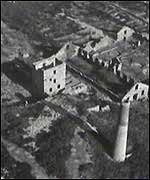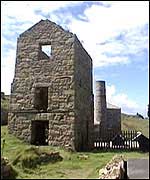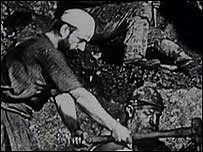|
They say that if you look down any hole in the ground
around the world, you'll find a Cornishman digging for tin.
We transport you back in time to recapture a century
of tin mining in Cornwall. Meet the Cornish miners who risked their lives
toiling in the tin mines to hack out this vital metal from the rock face.
Experience the working lives of the miners, go down the
mine shaft in the miners' cage and witness the treacherous conditions
below ground.
Cradle of the Industrial Revolution
Nowhere in the world was tin mining so engrained into
the local culture as Cornwall in the 19th and 20th centuries.
 |
| The early Cornish 'bal maidens' in the 1860s. |
Tin mining has existed in Cornwall for 2,000 years, since
the Bronze Age. But the last 100 years of the industry were to prove the
most turbulent in its history with cycles of boom and bust.
A rarely-seen film from 1947 called Tin Decontrolled
shows miners working by candelight at Luckett Tin Mine. These primitive
working methods were to change little up to the 1970s.
South Crofty - A Tour of the Mine shows
tin miners making the precarious descent 1,860 feet below ground and working
half-naked in near-suffocating conditions.
Although predominantly a male industry, women workers
were also employed in the tin mines. The
Silent Valley shows remarkable footage of 'bal maidens' smashing
up rocks above the mine under the supervision of 'bal cappens' in the
1930s.
Changing Fortunes
At the height of its prosperity the Cornish tin industry
employed 40,000 miners in 2,000 mines.
 |
| Cornwall produced £2,000 million of tin from
its mines |
Tin Mining Archive is a BBC film looking
at the old Cornish tin mines that once produced half of the world's tin.
Go below ground at Wheal Jane and watch the miners 'mucking out' hundreds
of tons of loose rock to get at the tin ore.
Cornish Farmer Turns Tin Miner (1949) tells the
story of Rex Tremlett who was trying to rework an old mine on his farm
in a period of recovery just after the Second World War.
Tin Prospecting from the Dartington Archive shows
how the tin industry experienced another boom in the 1960s when new prospectors
sought their fortunes including one entrepreneur with 'a revealer' designed
to locate tin reserves.
�5m Gamble(1967) shows miners working
the lode and bringing tin up the surface in a period of relative prosperity.
Boom to Bust
Horizon: Mines, Minerals and Men(1974) looks
at the changing fortunes of the industry and visits Geevor, once one of
Cornwall's most productive mines.
 |
| Today the old tin mines are tourist attractions |
400 tonnes of ore could be produced by the best miners
in a single shift at Geevor, but twelve years later the mine was to close.
Once Upon A Mine (1986) captures the ghostly,
deserted Victory Shaft at Geevor just weeks after the miners were laid
off.
Periods of boom and bust were common in the tin industry.
St Just charts the rise and fall of a typical Cornish tin mining
town and shows how the town was on the verge of becoming a 'ghost town'.
Tin Men
Miners needed great strength and courage to work in the
unforgiving environment of a tin mine.
In The Mathematics of the Mole (1962) tin miners
remember that it was so hot underground that they had to empty the sweat
from their boots.
The film brilliantly illustrates the subterranean life
of miners. It also shows how, despite the cramped and dangerous conditions,
there was a close-knit "family atmosphere".
This camaraderie is also captured in The Dartington
Archive which shows miners singing hymns and carols underground.
Mining Disasters
October 20, 1919 was one of Cornish tin mining's darkest
days. Yesterday's Witness: The Levant Mine Disaster (1970) shows
miners recalling one of the worst ever mining disasters.
Thirty one men died when the main engine rod at the mine
collapsed.
One miner was trapped for 53 hours, only to die later
on the surface. The last body was not recovered
till five days after the accident.
Levant Mine Memories reveals that it was symptomatic
of an industry on its knees. Years of under-investment had taken their
toll on what was once "the champion of Cornish mines".
Danger - Men at Work
Working in a subterranean world, miners coped with dirt,
extreme heat and humidity, and impenetrable darkness.
 |
| Working underground came with many hazards |
Death and injury were a fact of life with rockfalls,
explosions and falls being common. The Silent Valley shows
how miners were prone to accidents, and reconstructs life below ground
at a typical 1860s tin mine.
The Mathematics of the Mole (1962) shows miners
using mechanical drills which threw up huge clouds of dust and caused
damage to men's lungs.
Miners were prone to appalling diseases such as silicosis
as a result of working in dusty, airless conditions.
The Tin Miner They Couldn't Kill (1972) is a BBC
documentary about a retired miner called Leo Beskeen who reminisces about
tin mining in the early years of the century.
He remembers how safety rules were sometimes relaxed
to maximise production resulting in men taking risks.
It wasn't
just the underground workers who faced hazards.
South Crofty shows remarkable footage of men loading arsenic
onto wagons with nothing but handkerchieves and cloth covering their faces.
Between a Rock and a Hard Place
After 3,000 years of Cornish mining, the writing was
on the wall for the industry when tin prices crashed in 1985.
The BBC film Once Upon a Mine (1986) shows tin
miners at Geevor marching to save their jobs and lobbying the government.
 |
| Since the early days tin miners worked long and
hard hours |
But their pleas fell on deaf ears, and Geevor was forced
to close with the loss of 370 jobs. Join the shift on their last day at
Geevor and go inside the mine's shower room to hear the men protesting
about the closure.
The Last Mine (1998) shows life underground at
South Crofty Mine which was to hold out for another decade. Watch the
miners ascending for the last time following the announcement of the mine's
closure in 1998.
This poignant archive illustrates the end of almost 2,000
unbroken years of tin mining in Cornwall.
Aftermath
After the mines closed and the jobs were lost, there
was to be another victim - the environment.
Muddy Water (1992) shows how ten million gallons
of polluted water spewed out of Nangiles Mine into surrounding rivers
causing a major environmental disaster.
As the toxic tide of water flooded out of the old mine
shafts, it was the final reminder that we were watching the last death
throes of Cornish tin mining.
|

